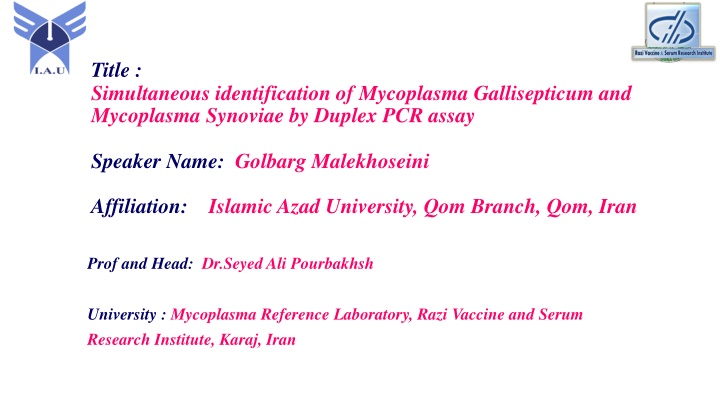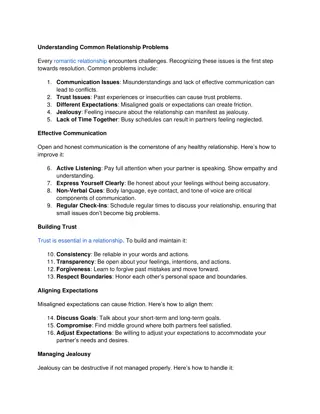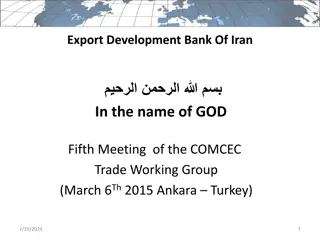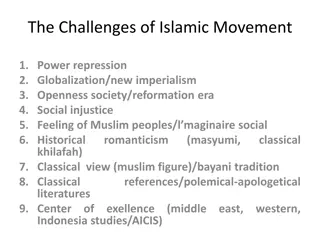
Simultaneous Identification of Mycoplasma Gallisepticum and Mycoplasma Synoviae using Duplex PCR Assay
Discover how Mycoplasma Gallisepticum and Mycoplasma Synoviae can be simultaneously identified through a Duplex PCR assay, with insights into their impact on poultry, classification, and structure. Learn about the economic losses these pathogenic species can cause in the poultry industry.
Download Presentation

Please find below an Image/Link to download the presentation.
The content on the website is provided AS IS for your information and personal use only. It may not be sold, licensed, or shared on other websites without obtaining consent from the author. If you encounter any issues during the download, it is possible that the publisher has removed the file from their server.
You are allowed to download the files provided on this website for personal or commercial use, subject to the condition that they are used lawfully. All files are the property of their respective owners.
The content on the website is provided AS IS for your information and personal use only. It may not be sold, licensed, or shared on other websites without obtaining consent from the author.
E N D
Presentation Transcript
Title : Simultaneous identification of Mycoplasma Gallisepticum and Mycoplasma Synoviae by Duplex PCR assay Speaker Name: Golbarg Malekhoseini Affiliation: Islamic Azad University, Qom Branch, Qom, Iran Prof and Head: Dr.Seyed Ali Pourbakhsh University : Mycoplasma Reference Laboratory, Razi Vaccine and Serum Research Institute, Karaj, Iran
Table of Content (summary slide) Introduction Objectives Methods and Material Result & Discussion Conclusion Summary References 28.3.2017 2
Introduction Mycoplasmas are the smallest prokaryote and can pass from 0.45 micron fillteration.thay donot have cell wall, so they resistant to effective antibiotics on the bacterial wall. They have smallest genome (0.58-1.38 Mbp) or (600-1350Kb) and independent replication They are facultative anaerobic and they need to 10% co2. They provide carbohydrates, lipid, amino acid from their host. They need to colestrol for setting the temperature and fluiding membrance . Mycoplasma 16SrRNA analysis showed that they have near relationship with Clastredums and Lactobacilluse . They can cause to disease in plants, animals and insect. 3 28.3.2017
Classification of bacteria Kingdom Kingdom Bacteria Bacteria Phylum Phylum Tenericutes Tenericutes Class Class Molicutes Molicutes Order Order Mycoplasma tales Mycoplasma tales M.gallisepticum M.gallisepticum Spiroplasmataceae Spiroplasmataceae M.synoviae M.synoviae Mycoplasma Mycoplasma Genus Genus Mycoplasmataceae Mycoplasmataceae Family Family M.hominise M.hominise Ureaplasma Ureaplasma Acholeplasmata les Acholeplasmata les 4 28.3.2017
Structure of Mycoplasma 28.3.2017 5
Mycoplasma Synoviae & Mycoplasma Gallisepticum Mycoplasma Synoviae(MS) and Mycoplasma Gallisepticum(MG) are two pathogenic species in bird that can cause too economic losses. Infection with MG has different clinical protests may be choronic respiratory disease and broiler carcass quality loss, are the highest incidence MG was known as one of the creator in complex disease and also relation between MG with different respiratory such as(Newcastle virus, Influenza type A), E.coli , Heamophiluse paragalynarum are known. MS is one of the most important pathogens in Turkey and chicken, that causes great economic losses in poultry industry evry year. Although it was introduced as causative agent of infectious synovitis, but nowadays also it was introduced as a respiratory illness and infection of the air sacs 28.3.2017 .6
Objectives Several Mycoplasma can cause Micoplasmosis in poultry. Among them MG and MS are the most important. They can cause economical losses to the poultry industry. Economical losses of Mycoplasma such as breathing problems or infection with virus and bacteria under poor sanitary condition. Till now immonological and molecular methods were used to identify MG and MS. But where as with Duplex PCR we can identify MG and MS at the same time and also we can save time and cost. So we decided to set up this technique for identification MG and MS. 28.3.2017 7
Hypothesis There are several discussions such as Gene that was selected to distinguish MG was 16SrRNA and vlhA gene is used for identification MS. MS is more sensetive than MG. So MG is more likely to grow than MS. So it is more likely to identify than MS. As where as the size MG gene (183bp) is smaller than MS(350bp). So MG is more sensetive than MS and also number of MG amplified fragments are more than MS. 28.3.2017 8
vlhA gene Sequenceofaminoacides116 to 319 have changes dueto rearrangement MSPB MSPB conserved region MSPBvariabel region PRR MSPA SP K116 Addition or delition in this region cause to change longth of protein . nt - 1 75 9 28.3.2017
VlhA protein Antigenic diversity in MSPA is more than MSPB MSPA helps to junction 10 28.3.2017
Materials and Methods PPLO-BROTH Glucose PPLO AGAR Glucose Swine Serum Yeast extract Cysteine hydrocholoride NAD Thallium acetate Penicillin G Distilled Water Ph:7.8 1-Coloration With Gimsa and Bludumtyln Swine Serum Yeast extract Cysteine hydrocholoride NAD Phenol red Thallium acetate Penicillin G Distilled Water Ph:7.8 2-Culture PPLO-BROTH PPLO- AGAR 3-Biochemical test Immunodiffusion RSA Cold Agglutination 4-Immunology tests PCR REAL TIME-PCR MULTI PLEX PCR RAPD PCR 5- Molecular Methods 11 28.3.2017
Molecular Methods 28.3.2017 12
Multiplex PCR StrainA strainB strainC strainD D A B C 13 28.3.2017
Duplex PCR and Single Template B1 A1 Set up reaction Run Duplex PCR B2 A2 A B 30 CYCLE 14 28.3.2017
Duplex PCR and two Template StrainA Strain B A1 B1 Set up reaction Run Duplex PCR A2 B2 A B 30 CYCLE 15 28.3.2017
Materials and Methods Samples were collected from commercial poultry flocks in central region Iran (Qom (Central province, Kashan, and Esfahan).The Most of the samples were obtained from flocks with clinical signs of a probably infection by Mycoplasma spp (MG,MS) .Taking 50 samples included air sac, choanal -cleft and tracheal swabs from flocks. Then aliquot of 0.5 ml was removed to a 1.5 ml tube for the DNA extraction. After filtering by 0.45 filters, 0.3 ml sample was taken for broth culture, PPLO broth and PPLO agar medium. Broth and agar media were incubated under micro aerophilic condition with 98% relative humidity and checked for color changes of broth two passages. 16 28.3.2017
Primers and formula reaction of PCR for checking mycoplasma genus Samples were avaluated to genus Mycoplasma PCR. Primer sequence and formula of reaction is explained as follow : M1F: 5'-GCTGCGGTGAATACGTTCT-3', M1R: 5'-TCCCCACGTTCTCGTAGGG-3'. 163 bp Formula in volume of 25 PCR Buffer 4.5 Mgcl 3 dNTP 0.8 primer 0.2+0.2 Taq DNA Polymerase 0.75U 2 17 28.3.2017
Device program for mycoplasms genuse Number of cycle 1 Time duration 6 min 60 sec 15 sec 30 min 6 min Temperature 84 C 96 C 56 C 72 C 72 C Stage name Initial denaturation Secendary denaturation Connect primers Primary extention Final extension 35 1 Then we did species PCR to identify MG and MS on the positive gene samples. We used of primer of vlhA gene for MS and 16SrRNA for MG. Primer sequence and reaction formula are explained to follow. 18 28.3.2017
Primers sequence and PCR reaction to distinguish MS MSConsF: TACTATTAGCAGCTAGTGC MSConsR :AGTAACCGATCCGCTTAAT Formula in volume of 25 PCR Buffer 3.5 Mgcl 3 dNTP 0.3 primer 0.4+0.4 Taq DNA Polymerase 1u 350 bp 2 Number of cycle 1 Time duration 2 min Temperature 84 C Stage name Initial denaturation Secendarydenaturation 30 sec 96 C Connect primers Primaryextention Final extension 30 sec 20 sec 6 min 35 56 C 72 C 72 C 1 28.3.2017 19
Primers sequence and PCR reaction to distinguish MG MGConsF: GAG CTA ATC TGT AAA GTT GGT C MGConsR : GCT TCC TTG CGG TTA GCA AC Formula in volume of 25 PCR Buffer 2.5 Mgcl 2 dNTP 0.5 primer 0.1+0.1 Taq DNA Polymerase 1.2 U 183 bp 2 Number of cycle 1 Time duration 3 min 30 sec 30 sec 60 sec 5 min Temperature 94 C 94 C 55 C 72 C 72 C Stage name Initial denaturation Secendary denaturation Connect primers Primary extention Final extension 40 1 28.3.2017 20
Duplex PCR Formula in volume of 25 PCR Buffer 6 l Mgcl 5 l dNTP 2 l primer MG(0.6F+0.6 R) ,MS(0.6F+0.6R) Taq 0.5 l Number of cycle Time duration 1 5 min 30 sec 40 30 sec 2 min 1 7 min 2 Temperature 94 C 94 C 54 C 72 C 72 C Stage name Initial denaturation Secendarydenaturation Connect primers Primaryextention Final extension 21 28.3.2017
Results After sampling (50 samples), DNA was extracted with phenol chloroform method, then genes PCR reaction was conducted .we did single PCR for identification MG species and MS species on 20 samples that were positive in genes PCR. Among them 7 samples were MS positive, 7 samples were MG positive and 3 samples were negative. Where as Duplex PCR for distingushing MG and MS was conducted for first time. So at the first we setup it with positive control. Then other samples were checked with this technique. 28.3.2017 22
PCR results Total samples Positive genus PCR Positive MG PCR Positive MS PCR Samples include MS and MG 3 20 7 7 50 Duplex PCR results Total samples Positive MG Duplex PCR Positive MS Duplex PCR Positive MG/MS Duplex PCR 20 4 2 3 28.3.2017 23 26/9/2017
Pictures Mycoplasma genus PCR 1:Lader 2:Positive control 3:Negative control 4:MG1 5:Mga 6: 135/5 7:MSH 8:MS 9:138/5 10:MS86 24 28.3.2017
Pictures MS species PCR MG species PCR 350 bp 183bp 1: Lader 2:Positivecontrol 3:Negative control 4:MSH 5:MSV 6:MS86 7:138 8:40 1: Lader 2:Positivecontrol 3:Negative control 4:MG100 5,6,7:Unknown samples 25 28.3.2017
Pictures Duplex PCR 350 bp 183 bp 1: Lader 2: Negative control 3: MG Positive control 4: MS Positive control 5, 6: Duplex PCR 26 28.3.2017
Discussion Nowadays in addition to PCR, different methods use for identification microorganisms KathleenA. Stellrecht (2003), used of Multiplex PCR to identify Ureaplasma, Mycoplasma genitalium and Mycoplasma hominise. A.V.Sprigin (2010) ,by Duplex REAL-TIME Taqman PCR checked MG and MS in clinical samples. In this study we could do simultaneously identify MG and MS by Duplex PCR assay .we used 16SrRNA for identification Mycoplasma genus and MG .Also we used vlhA gene to distinguish MS. All of samples (field and positive samples) were identified. duplex PCR is more rapid and inexpensive method than the single PCR for detection of MG & MS. 28.3.2017 27
Conclusion The results of this study showed that Duplex PCR is faster and inexpensive method than the single PCR for detection of MG & MS. So Duplex PCR can be an alternative method for PCR to detect MG & MS with each other. In the present study Duplex PCR is more capable to identify MG than MS and bands of MG are stronger than bands of MS. This study suggested for better identification of MS, it could be changed in program or master mix. 28.3.2017 28
Summary Mycoplasma gallisepticum (M.G) and Mycoplasma synoviae (M.S) have been recognized as common respiratory pathogens especially in chickens causing lots economical losses in poultry industries .The aim of this study was to develop and validate Duplex Polymerase Chain Reaction (Duplex PCR) for simultaneous detection of MG & MS . The research was conducted in Mycoplasma Reference Laboratory, Razi Vaccine and Serum Research Institute, Karaj, Iran. A total of 50 samples from tracheas, lungs and air sacs were taken from commercial broiler chicken farms in Iran . The samples were cultured in PPLO broth supplemented for M.S and M.G isolation and bacteria DNA were extracted by phenol/chloroform extraction method. 28.3.2017 29
Summary The conserved region of 16SrRNA gene which was applied for the detection of Mycoplasma genus in 163bp fragment and MG in 183 bp fragment and vlhA gene was also employed for detection of MS in 350 bp fragment. Hence, Duplex PCR amplified the conserved region of 16SrRNA and vlhA gene which were applied for detection of MG &MS. 20 samples in Mycoplasma genus, and 7 samples in MG & MS were positive in the single PCR whereas in 3 samples of MG & MS were simultaneously positive in the Duplex PCR method. The results showed that Duplex PCR was successful to identify MG & MS at the same time and suggested that duplex PCR is more rapid and inexpensive method than the single PCR for detection of MG & MS. 28.3.2017 30
Thanks for your attention 28.3.2017 31
Reference [1] Bardbury J.M; Kleven, S.H.(2003). Mycoplasma Iowa Infection. in: disease of poultry .11th edition . Saif . Y. M et all. Iowa State University Press. P: 766-772. [2] Bercic R.L; Slavec, B; Lavric, M; Narat, M; Bidovec, A; Dovc, Peter; Benecina, D. (2007). Identification of major hmmunogenic proteins of mycoplasma synoviae isolates. Veterinary microbiology. Preprint. [3] Carnaghan, R.B.A.1961. Egg transmission of infectious synovitis. J Comp Pathol 71: 279-285. [4] Collett, S.R. (2005). Monitoring broiler breeder flocks for Mycoplasma gallisepticum infection after vaccination with ts- 11. Department of production animal studies, faculty of veterinary science, university of Pretoria, pp: 1-79. [5] Dowling, L. (1984). Toxicity of Ionophores. Vet Rec. 114-128. [6] Dohms, J.E., Hnatow, L.L., Whetzel, P.Morgan, R., and Keeler, C.L.Jr. (1993). Identification of the putative cytadhesion gene of Mycoplasma gallisepticum and its use as a DNA probe. Avian Diseases 37:380-388. [7] Fan, H.H., Kleven, S.H and Jackwood, M.W. (1995). Application of polymerase chain reaction with arbitrary primers to strain identification of Mycoplasma gallisepticum. Avian Diseases 39:729-735. [8] Fan, H.H., Kleven, S.H., Jachwood, M.W., Johansson K.E., Pettersson, B., and Levisohn, S. (1995). Species identification of avian Mycoplasma by polymerase chain reaction and restriction fragment length polymorphism analysis. Avian Diseases 39:398-407 [8] Garia , M., Jachwood M.W., Levisohn, S., Kleven, S.H. (1999). Use of specific-specefic oligoucleotid probe to detect Mycoplasma gallisepticum, M. synoviae, and M. iowa PCR amplitication products. J.Vet. Diag. Invest. 8(1), p: 56-63 [9] Ley, D.H (2008). Mycoplasma gallisepticum infection. In: Saif Y.M., Barnes H.J., Glisson J.R, Fadly A.M., McDougald L.R. & D.E, Swayne eds. Disease of poultry, 12th Edition, Iowa State University Press, lowa, USA, pp: 808-834 [10] Liu, T., M. Garcia, S. Levisohn, D. Yogev, and S. H. Kleven.(2001). Molecular variability of theuu adhesion-encoding gene pvpA among Mycoplasma gallisepticum strains and its application in diagnosis. Journal of Clinical Microbiology 39:1882-1888. [11] Lysnyansky, I., M. Garcia, and S. Levisohn. (2005). Use of mgc2-polymerase chain reaction-restriction fragment length polymorphism for rapid differentiation between field isolates and vaccine strains of Mycoplasma gallisepticum in Israel. Avian Diseases 49:238-245. 28.3.2017 32






















